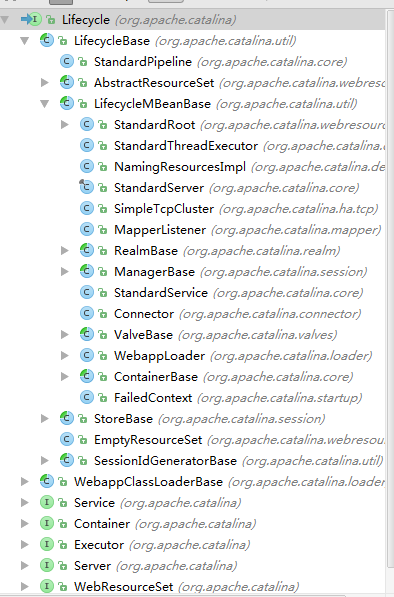一,回顾
还记得我们在启动二讲过的嘛?container的启动和初始化讲完了,connector还没开始。下面,我们开始看connector是如何初始化和启动的。
二,再读Lifecycle

我们看Lifecycle的类层次图,发现很多类都实现了Lifecycle,包括connector和container,这里我只关心connector。由于Connector继承了LifecycleBase,跟container一样,当调用其init和start方法时,会调用其内部的initInternal和startInternal方法,下面我们就关注其方法。
三,Connector的initInternal
看方法:
protected void initInternal() throws LifecycleException {
super.initInternal();
// Initialize adapter
adapter = new CoyoteAdapter(this);
protocolHandler.setAdapter(adapter);
try {
protocolHandler.init();
} catch (Exception e) {
throw new LifecycleException
(sm.getString
("coyoteConnector.protocolHandlerInitializationFailed"), e);
}
}
这里我们要重点关注protocolHandler,它是怎么创建的呢?我们看Connector的创建。
3.1 创建Connector
在Catalian的createStartDigester()方法中,有这样一段代码:
Catalian
digester.addRule("Server/Service/Connector",
new ConnectorCreateRule());
我们看代码,这里创建了一个ConnectorCreateRule对象,到这个里面看看。
ConnectorCreateRule
public void begin(String namespace, String name, Attributes attributes)
throws Exception {
Service svc = (Service)digester.peek();
Executor ex = null;
if ( attributes.getValue(“executor”)!=null ) {
ex = svc.getExecutor(attributes.getValue(“executor”));
}
Connector con = new Connector(attributes.getValue(“protocol”));
if (ex != null) {
setExecutor(con, ex);
}
String sslImplementationName = attributes.getValue(“sslImplementationName”);
if (sslImplementationName != null) {
setSSLImplementationName(con, sslImplementationName);
}
digester.push(con);
}
中间有一句new Connector(attributes.getValue("protocol"));,好家伙,我们看看Connector的构造方法。
public Connector(String protocol) {
setProtocol(protocol);
// Instantiate protocol handler
ProtocolHandler p = null;
try {
Class<?> clazz = Class.forName(protocolHandlerClassName);
p = (ProtocolHandler) clazz.newInstance();
} catch (Exception e) {
log.error(sm.getString(
"coyoteConnector.protocolHandlerInstantiationFailed"), e);
} finally {
this.protocolHandler = p;
}
...//other
}
//默认类为Http11NioProtocol
protected String protocolHandlerClassName =
"org.apache.coyote.http11.Http11NioProtocol";
我们看到,这里用反射创建了一个ProtocolHandler,默认为Http11NioProtocol,并且根据server.xml属性配置设置了协议。
3.2 Http11NioProtocol的init
我们看代码:
AbstractHttp11Protocol
public void init() throws Exception {
for (UpgradeProtocol upgradeProtocol : upgradeProtocols) {
configureUpgradeProtocol(upgradeProtocol);
}
super.init();
}
调用了父类的init
AbstractProtocol
public void init() throws Exception {
if (oname == null) {
// Component not pre-registered so register it
oname = createObjectName();
if (oname != null) {
Registry.getRegistry(null, null).registerComponent(this, oname,
null);
}
}
if (this.domain != null) {
try {
tpOname = new ObjectName(domain + ":" +
"type=ThreadPool,name=" + getName());
Registry.getRegistry(null, null).registerComponent(endpoint,
tpOname, null);
} catch (Exception e) {
getLog().error(sm.getString(
"abstractProtocolHandler.mbeanRegistrationFailed",
tpOname, getName()), e);
}
rgOname=new ObjectName(domain +
":type=GlobalRequestProcessor,name=" + getName());
Registry.getRegistry(null, null).registerComponent(
getHandler().getGlobal(), rgOname, null );
}
String endpointName = getName();
endpoint.setName(endpointName.substring(1, endpointName.length()-1));
try {
endpoint.init();
} catch (Exception ex) {
getLog().error(sm.getString("abstractProtocolHandler.initError",
getName()), ex);
throw ex;
}
}
AbstractEndpoint
public final void init() throws Exception {
if (bindOnInit) {
bind();
bindState = BindState.BOUND_ON_INIT;
}
}
先调用bind方法,绑定端口:
public void bind() throws Exception {
serverSock = ServerSocketChannel.open();
socketProperties.setProperties(serverSock.socket());
InetSocketAddress addr = (getAddress()!=null?new InetSocketAddress(getAddress(),getPort()):new InetSocketAddress(getPort()));
serverSock.socket().bind(addr,getBacklog());
serverSock.configureBlocking(true); //mimic APR behavior
serverSock.socket().setSoTimeout(getSocketProperties().getSoTimeout());
// Initialize thread count defaults for acceptor, poller
if (acceptorThreadCount == 0) {
// FIXME: Doesn't seem to work that well with multiple accept threads
acceptorThreadCount = 1;
}
if (pollerThreadCount <= 0) {
//minimum one poller thread
pollerThreadCount = 1;
}
stopLatch = new CountDownLatch(pollerThreadCount);
// Initialize SSL if needed
initialiseSsl();
selectorPool.open();
}
四,Connector的startInternal
直接上方法:
protected void startInternal() throws LifecycleException {
...//检验
setState(LifecycleState.STARTING);
try {
protocolHandler.start();
} catch (Exception e) {
throw new LifecycleException
(errPrefix + " " + sm.getString
("coyoteConnector.protocolHandlerStartFailed"), e);
}
}
方法很简单,调用了protocolHandler的start方法。
4.1 Http11NioProtocol的start
public void start() throws Exception {
try {
endpoint.start();
} catch (Exception ex) {
getLog().error(sm.getString("abstractProtocolHandler.startError",
getName()), ex);
throw ex;
}
}
代码直接启动了endpoint,在Http11NioProtocol为NioEndpoint对象,这里就不解释了。
我们看其内部方法:
AbstractEndpoint
public final void start() throws Exception {
if (bindState == BindState.UNBOUND) {
bind();
bindState = BindState.BOUND_ON_START;
}
startInternal();
}
代码采用Blocking模式接收连接请求。接着调用了startInternal方法:
public void startInternal() throws Exception {
if (!running) {
running = true;
paused = false;
processorCache = new SynchronizedStack<>(SynchronizedStack.DEFAULT_SIZE,
socketProperties.getProcessorCache());
eventCache = new SynchronizedStack<>(SynchronizedStack.DEFAULT_SIZE,
socketProperties.getEventCache());
nioChannels = new SynchronizedStack<>(SynchronizedStack.DEFAULT_SIZE,
socketProperties.getBufferPool());
// Create worker collection
if ( getExecutor() == null ) {
createExecutor();
}
initializeConnectionLatch();
// Start poller threads
pollers = new Poller[getPollerThreadCount()];
for (int i=0; i<pollers.length; i++) {
pollers[i] = new Poller();
Thread pollerThread = new Thread(pollers[i], getName() + "-ClientPoller-"+i);
pollerThread.setPriority(threadPriority);
pollerThread.setDaemon(true);
pollerThread.start();
}
startAcceptorThreads();
}
}
代码首先创建了线程池,然后初始化了最大连接限制,启动了poller线程,和acceptor线程。这样,整个流程就结束了。Poller主要作用于socket读写事件,Acceptor主要作用于接收请求。